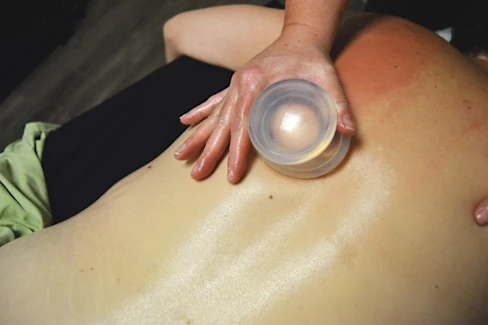Myofascial Cupping: What to Expect at Your First Appointment
Monday, March 21, 2022, 12:15 PM
What is Myofascial Cupping?
Myofascial cupping is a soft tissue therapy that encourages healing by creating suction on the skin using plastic or glass cups. The suction pulls up underlying tissues, blood, and other fluids close to the surface of the skin.
Myofascial is a common term in holistic health. It means "of or relating to the fascia surrounding and separating muscle tissue" (Dictionary.com).
To get an inside view on myofascial cupping, we spoke with NHPC member Winona Mondor, who has been practising cupping since 1999 and teaching cupping across Canada since 2012.
"Myofascial cupping is very effective at releasing and healing tight hardened tissues with adhesions," Winona shares. "We use the cups to lift, separate, and cleanse by pulling healthy fluid into the area while flushing out the cellular debris that is contributing to pain and immobilization."

Myofascial cupping is one of many modalities that the NHPC recognizes, and practitioners must have special training or certification to practise it.
Who Can Benefit from Myofascial Cupping?
"Most clients find cupping relaxing and love the benefits of deep and profound tissue release and healing, reduction of pain, and better range of movements," Winona says.
Myofascial cupping can be beneficial for many symptoms and conditions, especially those related to soft tissue, musculoskeletal tension, pain, and common sporting injuries. Winona has also treated clients to reduce edema and stimulate bowel function.
This treatment can be very relaxing, as it is often incorporated into other manual therapy techniques such as massage therapy, which stimulates the parasympathetic nervous system to slow your heart rate and aid in digestion. Cupping can be a wonderful addition to your next massage therapy treatment.
Winona warns that cupping should never be done on or near acute injuries or over areas with vessels, hardware, or near herniation. Cupping is not recommended for individuals with blood clotting disorders or certain skin conditions.
"Each client has their main treatment goal," Winona says. "Your therapist will make an assessment to ensure the safety and viability of cupping on an individual basis."
Consult with your health care professional if you are unsure whether this treatment is right for you.
What Can You Expect at Your First Myofascial Cupping Treatment?
Myofascial cupping uses cups made of glass, silicone, or plastic; some have soft squeezable bulbs at one end, and some can be attached to a machine or manual pump that creates the suction.
"Expect your therapist to use a generous amount of massage oil or cream to avoid unnecessary friction on your skin," Winona says.
A myofascial cupping treatment uses massage strokes to lift, separate, and stretch underlying soft tissue. Cupping is typically applied on the neck, shoulders, back, sacrum, hip, abdomen, thigh, calves, and upper arms.
The therapist uses massage techniques to locate areas of tension and may apply cups to an affected area for a few minutes at a time for deeper fascial release. The cups can be moved over the surface in a gliding motion or stationed on a fascial adhesion (scar tissue) or trigger point for a short time to reduce or eliminate it.
Does Cupping Hurt?
Contrary to what many people may think, cupping does not hurt. You may experience mild discomfort if you are tense, and it may feel odd if it's your first treatment.
In a deep-tissue, stationary technique, the stretching of the skin may create a temporary stinging or burning sensation as the connective tissues expand. However, you should always let your practitioner know if something feels painful or uncomfortable during treatment.
Cupping procedures may leave light to dark red or blue marks on the skin. These marks are caused by the suction of the cups and will disappear in five to 10 days.
Are There Other Types of Cupping?
There are variations of cupping, such as wet cupping and fire cupping.
The NHPC does not support wet cupping because it involves making small lacerations to the skin, which is considered invasive. Myofascial cupping is not considered an invasive treatment because it does not break the dermis of the skin with lancets or sterile needles.
The NHPC recognizes fire cupping, which is when the practitioner lights a flame inside a glass cup to depressurize it. Once extinguished, the cup is placed on the client's body to help encourage blood flow and enhance circulation.
Booking your Treatment
Be sure your practitioner has certification or education in myofascial cupping, and that they are registered with a professional organization like the NHPC.
Be honest in your client intake form about any existing conditions you know of, so your practitioner can make informed decisions about your treatment.
If you're ready to try it out yourself, find a practitioner in your area using the NHPC Member Directory.

